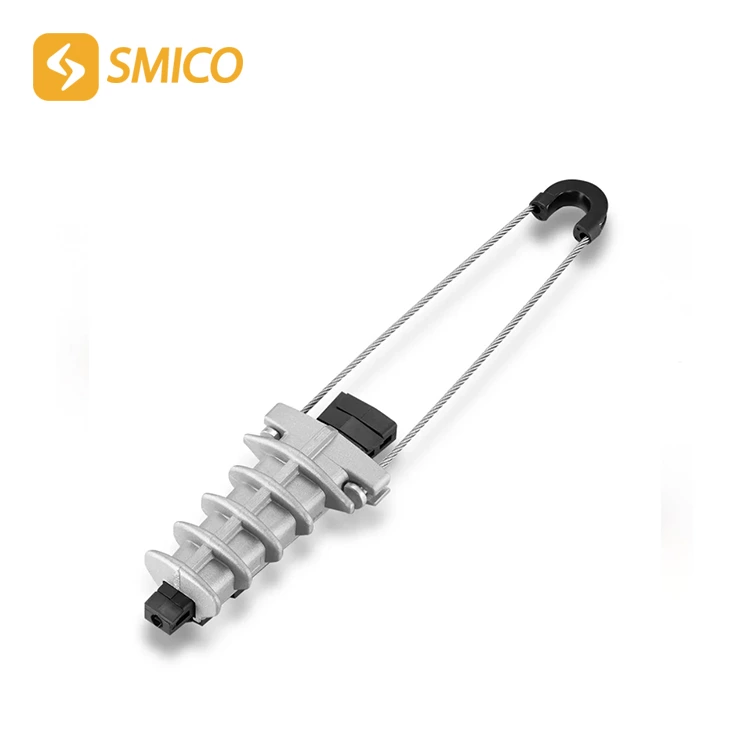Classification Of Wedge-type Tension Clamps For Power Fittings
dead end clamp for ab cable is used for connecting aluminum stranded wires or steel core aluminum stranded wires of small and medium cross-sections and steel stranded wires of overhead lightning arresters at positions that do not bear tension, and is also used for jumper connections of non-linear pole towers. Power engineering materials (metal fittings) are used to connect conductors to each other and are mainly used in power line projects.
dead end clamp for abc cable Structure
fungsi dead end clamp adopts a plate-plate structure and is made of aluminum alloy. The fastening pressure of the bolts is used to fix the connecting conductors in the upper and lower grooved clamps to complete the connection, and then the pressure is transmitted through flat washers and spring washers to provide a relatively uniform and constant pressure to the connecting conductors. It can be disassembled after installation and is often used in the jumper or ground wire overlap at the tension end of the line. In order to ensure that the wire clamp has sufficient and uniform pressure on the wire, clamp dead end generally adopts a two-bolt or three-bolt structure, and the installation requires uniform force when tightening each bolt. Sometimes, in order to ensure operational reliability, two or three wire clamps are used in parallel at equal distances during line construction. The gripping force of dead and clamp on the wire is about 10%-20% of the calculated breaking force of the wire.
dead clamp Generally, only wires of the same diameter are connected. The allowed wire span generally includes two adjacent specifications. For example, the applicable wire cross-section of dead end clamp overhead line is 185mm2 and 240mm2, so a symmetrical design is adopted in the structure.
dead end clamp with eye hook allows the span combination of wires within a certain diameter range to be continuous. The structure adopts an asymmetrical design, and the pressure plate is designed to be adjustable left and right to ensure that both wires of different diameters can obtain a relatively stable pressure when in contact, but human factors have a greater impact on the tightness of the bolts.
The material of the wedge-shaped parallel groove wire is generally forged aluminum, consisting of an arched body and a wedge block; installation or removal uses a gun-shaped special tool, but it cannot be reused. The slope of the two sides of the wedge block is the same as that of the body, which can make the wire evenly stressed in the contacted section and establish self-locking between materials; the arched body provides the elastic force required to maintain stable pressure. The radius of curvature of the inner groove of the bow-shaped body and the radius of the outer groove of the wedge are slightly larger than the radius of the largest applicable wire. During installation, the two straight wires to be connected are placed in the corresponding positions on both sides of the body, the wedge is pushed to the mark line position by manpower, and then the gun-shaped special tool is fired to generate an instantaneous thrust to press the wedge into the working position. The pressure on the wedge is mainly determined by the amount of medicine in the special bullet, which reduces the influence of human factors on the installation quality, so the consistency of dead end loop clamp installation is better. The wedge-shaped parallel groove wire clamp can connect two wires of equal diameter and different diameters. The gripping force of the wedge-shaped parallel groove wire clamp on the wire is about 20%-45% of the calculated breaking force of the wire.
The H-type parallel groove wire clamp is a compression structure, made of pure aluminum or aluminum alloy, and cannot be disassembled after installation. The wire clamp is named because the cross-section of the wire clamp is similar to the letter H. With the help of special hydraulic pliers, the wire clamp and the two connected wires can be pressed into a whole. After crimping, the contact part is elliptical and cylindrical, and the appearance is relatively compact. Similar to the wedge-type parallel groove wire clamp, its compression process is controlled by the output pressure of the hydraulic clamp, and the human influence is small. The H-type parallel groove wire clamp can connect two wires of equal diameter or different diameters. The wire span in the same slot is generally 3-4 specifications. When the H-type parallel groove wire clamp is connected to the wire, due to the circumferential force, the aluminum on the inner wall of the wire clamp undergoes plastic deformation and is embedded in the twisted gap of the outer layer of the wire. The effective contact surface is large. The gripping force of the H-type parallel groove wire clamp on the wire is about 40%-65% of the calculated breaking force of the wire.

